Building and description
During the First World War, several large liners of Glasgow-based Anchor Line (Henderson Bros) Ltd were lost, including the earlier Tuscania of 1914. Embarking on a replacement programme even before the end of 1918, the replacement Tuscania for the Mediterranean-New York service was built by Fairfield Shipbuilding and Engineering Company at Govan, Glasgow, as yard number 595. [1] [2] She measured 16,991 gross register tons (GRT) and 10,016 net register tons (NRT), was 552.3 ft (168.3 m) long between perpendiculars by 70.3 ft (21.4 m) beam and had a depth of 38.6 ft (11.8 m). [3] She had six Brown-Curtis steam turbines, also made by Fairfield, driving twin screws via double reduction gearing, giving her a speed of 15.5 knots (28.7 km/h; 17.8 mph). [2] [3] [4]
The ship was formally named Tuscania when launched on 4 October 1921, in the midst of the post-war economic slump, when many shipowners, Anchor Line included, had asked builders to slow or suspend building work. [4] Tuscania was not completed until almost a year later; she ran sea trials on 8 September 1922 and was registered at Glasgow with Official Number 146307. [2] [5] As completed, she has capacity for 2462 passengers (267 1st class, 377 2nd and 1818 3rd) and a complement of 342 officers and crew. [5]
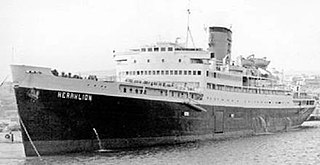
SS Heraklion was a roll on/roll off car ferry operating the lines Piraeus – Chania and Piraeus – Irakleio between 1965 and 1966. The ship capsized and sank on 8 December 1966 in the Aegean Sea, resulting in the death of over 200 people. Her demise was one of the greatest maritime disasters in Greek history.

MS Regal Empress was a cruise ship that recently operated for Imperial Majesty Cruise Line. She was built in 1953 by Alexander Stephen & Sons at Glasgow, Scotland as the ocean liner SS Olympia for the Greek Line. Greek Line withdrew the Olympia from service in 1974. Following an extended lay-up period and reconstruction into a diesel-engined Caribbean cruise ship, the ship re-emerged in 1983 as MS Caribe I for Commodore Cruise Line. In 1993 she was sold to Regal Cruise Line and received her final name. She operated for Imperial Majesty Cruise Line from 2003 until 2009. The Regal Empress was also the last vintage passenger ship to regularly sail from the United States.
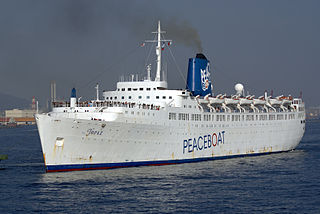
RMS Empress of Britain was a transatlantic ocean liner built by Fairfield Shipbuilding at Govan on the Clyde in Scotland in 1955-1956 for Canadian Pacific Steamships (CP). This ship — the third of three CP vessels to be named Empress of Britain — regularly traversed the trans-Atlantic route between Canada and Europe until 1964, completing 123 voyages under the Canadian Pacific flag.

RMS Empress of Japan was an ocean liner built in 1929–1930 by Fairfield Shipbuilding & Engineering Company at Govan on the Clyde in Scotland for Canadian Pacific Steamships (CP). This ship was the second of two CP vessels to be named Empress of Japan – regularly traversed the trans-Pacific route between the west coast of Canada and the Far East until 1942.

SS Tuscania was a luxury liner of the Anchor Line, a subsidiary of the Cunard Line and named after Tuscania, Italy. In 1918 the ship was torpedoed and sunk by the German U-boat UB-77 while transporting American troops to Europe with the loss of 210 lives.
Several ships have borne the name SS Tuscania, all in the Cunard-subsidiary Anchor Line. These include:
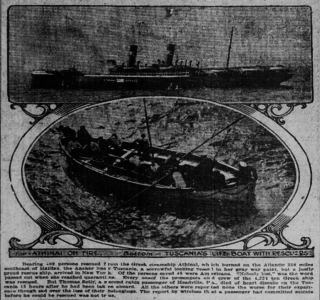
SS Athinai was a Greek transatlantic steamer that burned and sank on 19 September 1915.

USS Hugh L. Scott (AP-43) was a Hugh L. Scott-class transport ship. She was built in 1921 and spent 20 years in merchant service as a passenger and cargo liner. In July 1941 the ship was delivered to the United States Department of War for Army service as the United States Army Transport Hugh L. Scott operating in the Pacific. In August 1942 the ship was transferred to the United States Navy for conversion to an attack transport, served as a troopship in Operation Torch in November 1942, and was sunk by a U-boat four days later. 59 crewmen and soldiers died during the sinking.

RMS Empress of Canada was an ocean liner built in 1920 for the Canadian Pacific Steamships (CP) by Fairfield Shipbuilding & Engineering Company at Govan on the Clyde in Scotland. This ship—the first of three CP vessels to be named Empress of Canada—regularly traversed the trans-Pacific route between the west coast of Canada and the Asian waters until 1939.

MS Marella Spirit was a cruise ship owned by Holland America Line and operated under charter by the United Kingdom-based Marella Cruises. She was built in 1983 at the Chantiers de l'Atlantique shipyard in France for Holland America Line as MS Nieuw Amsterdam. Between 2000 and 2001 she sailed for United States Lines, a subsidiary of American Classic Voyages, as MS Patriot. In 2002 she returned under Holland America Line ownership and reverted to the name Nieuw Amsterdam, but was not used in active service. During the same year she was chartered to Louis Cruise Lines, who in turn sub-chartered the ship to Thomson Cruises, with whom she entered service under MS Thomson Spirit in 2003.

SS Letitia was an ocean liner built in Scotland for service with the Anchor-Donaldson Line. She continued to serve with its successor company Donaldson Atlantic Line. At the start of the Second World War in September 1939, the British Admiralty requisitioned the ship for service and had it converted to serve as an armed merchant cruiser. She was withdrawn from this service in 1941 to become a troop ship.
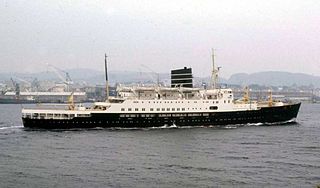
TS Leda was operated by Bergen Line between Britain and Norway as a North Sea ferry for over 20 years from 1953. She was rebuilt in 1981 as a cruise liner and later became an accommodation vessel at a penal colony for terrorists and members of the Mafia. In 2002, whilst being broken up, she was boarded by Greenpeace campaigners protesting about conditions in the shipbreaking industry.

SS Arthur M. Huddell is a Liberty ship built in the United States during World War II. She was named after Arthur M. Huddell, an American union leader. Huddell had been president of the Boston Central Labor Union, vice president of the International Engineers’ Union, and president of the International Union of Operating Engineers (IUOE).

The TSS Maunganui was a passenger vessel built by Fairfield Shipbuilding and Engineering Company, Govan for the Union Steamship Company of New Zealand and launched on 24 August 1911.
Anchor Line was a Scottish merchant shipping company that was founded in 1855 and dissolved in 1980.
SS Mohamed Ali El-Kebir, formerly SS Teno, was one of a pair of steam turbine ocean liners built in Scotland in 1922 for the Chilean company CSAV. She and her sister ship Aconcagua ran between Valparaíso and New York via the Panama Canal until 1932, when CSAV was hit by the Great Depression and surrendered the two ships to the Scottish shipbuilder Lithgows to clear a debt.
Andromachi was a 7,056 GRT cargo ship that was built as Empire Favour in 1945 by Caledon Shipbuilding & Engineering Co Ltd, Dundee for the Ministry of War Transport (MoWT). She was sold in 1947 and renamed Epsom. Sales in 1950 saw her renamed Tharros and Errington Court. In 1956, she was sold to Liberia and renamed Penelope. A further sale in 1961 saw her renamed Andromachi. She was set afire at Suez in June 1969 during the War of Attrition and was abandoned. The wreck was scrapped in 1976.

SS Nidd was a freight vessel built for the Goole Steam Shipping Company in 1900.

SS Katoomba was a passenger steamship that was built in Ireland 1913, spent most of her career in Australian ownership and was scrapped in Japan in 1959. McIlwraith, McEacharn & Co owned her for more than three decades, including two periods when she was a troopship. In 1946 the Goulandris brothers bought her for their Greek Line and registered her in Panama. In 1949 she was renamed Columbia.
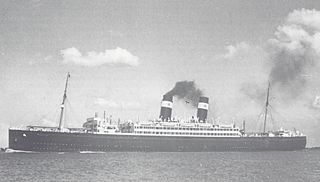
SS Pennland was a transatlantic ocean liner that was launched as Pittsburgh in Ireland in 1920 and renamed Pennland in 1926. She had a succession of UK, German and Dutch owners and operators. In 1940 she was converted into a troopship.
This page is based on this
Wikipedia article Text is available under the
CC BY-SA 4.0 license; additional terms may apply.
Images, videos and audio are available under their respective licenses.















